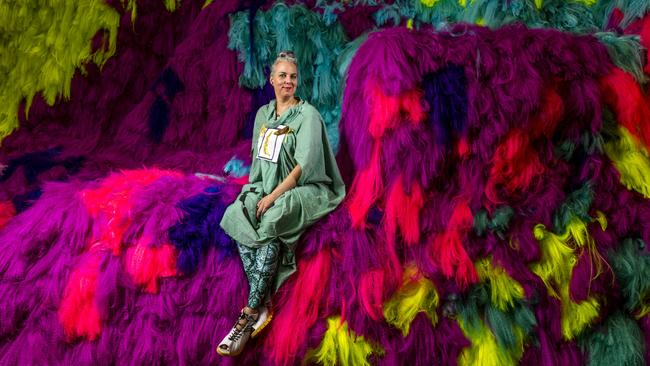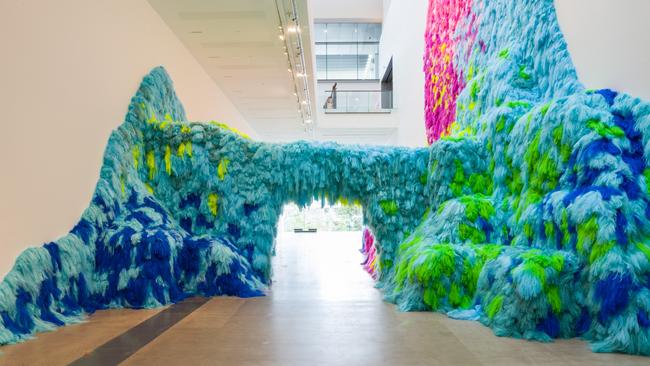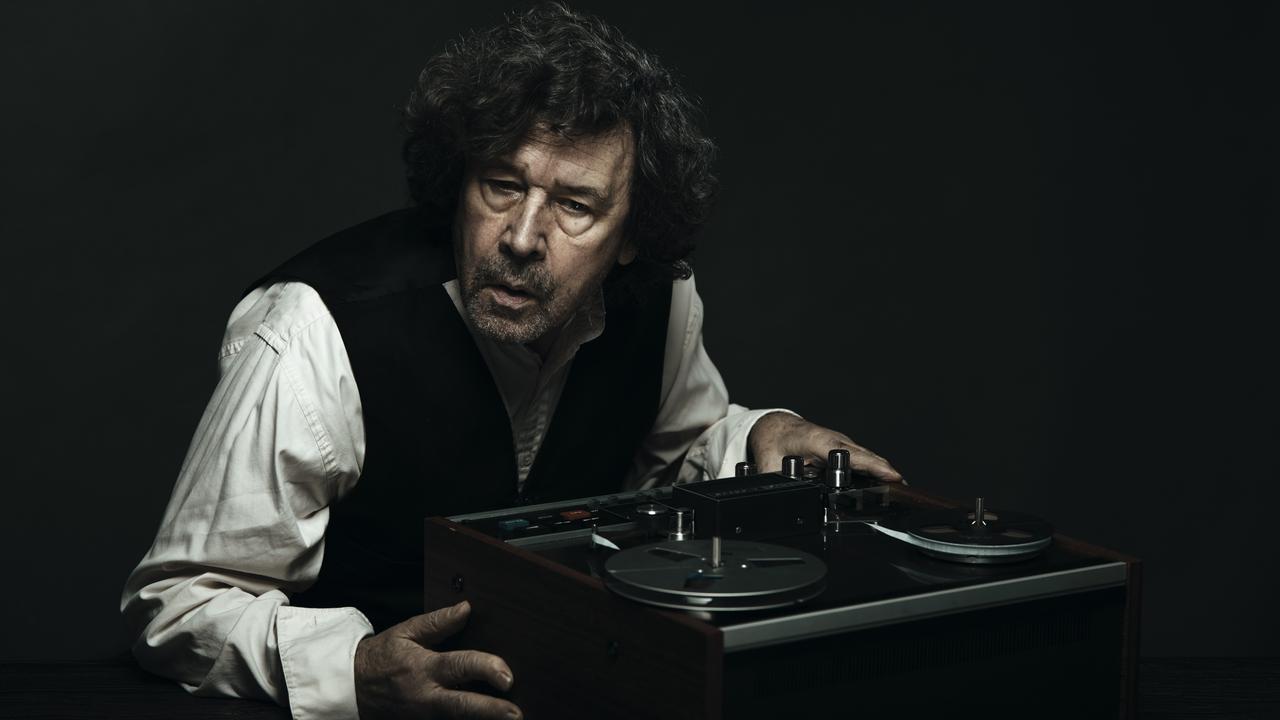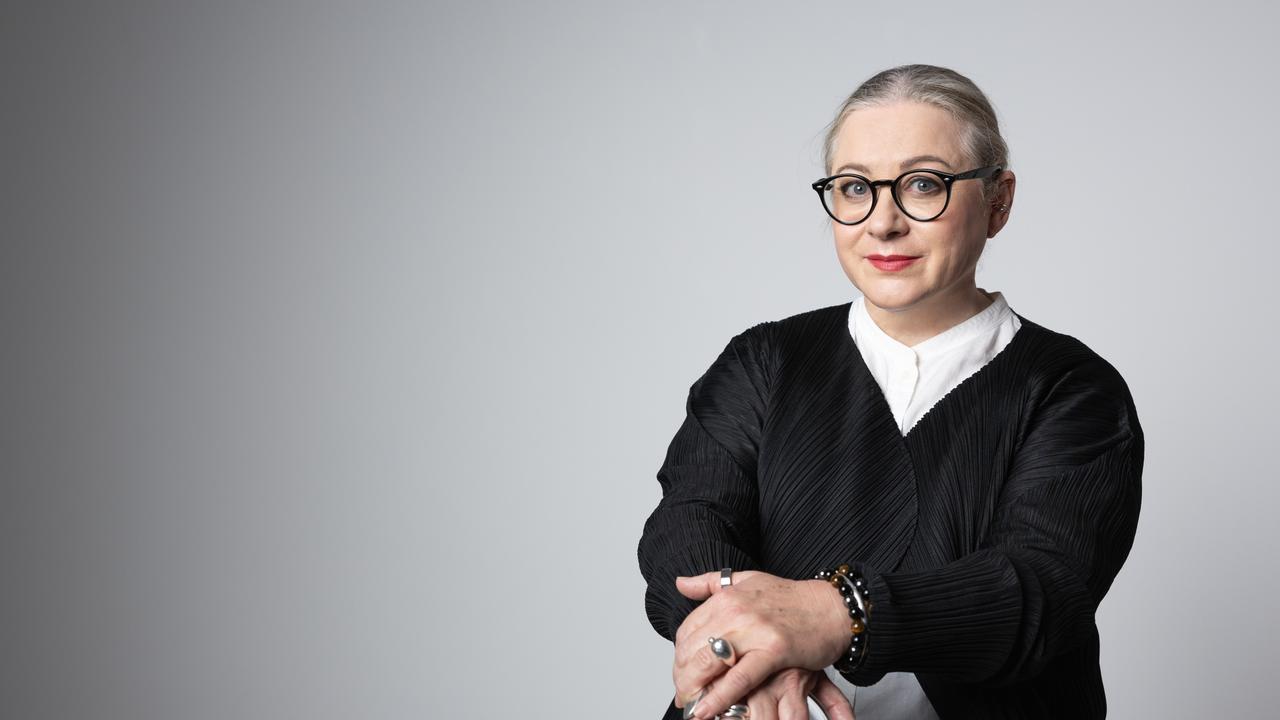GOMA’s 10th anniversary sparks a dazzling dress-up by Shoplifter
The 10th anniversary exhibition at Brisbane’s GOMA is enveloped in a remarkably bright installation by Shoplifter.

Affixed to the glass above the entrance to Brisbane’s Gallery of Modern Art is a large decal depicting a curious meeting of blue and orange. At first glance, the nature of the bright substance in the image is unclear: is it smoke, paint, fairy floss, or something even weirder? Positioned in the centre of this combination are some words — “GOMA Turns 10” — and on walking through the doors, another great bloom of colour reveals itself, positioned high up on the right wall, as if a psychedelic shagpile carpet has been transposed to the vertical plane.
It’s only upon journeying further into the building — past the fences that surround a towering, under-construction slippery slide — and turning right into the Long Gallery, however, that the mystery substance suddenly makes sense: it’s hair, and there’s a bloody lot of it. Stepping closer to take it all in, the first comparison to spring to mind is that a sizeable chunk of the Great Barrier Reef’s most spectacular section of coral has somehow been transplanted here. Two white walls are connected by a furry overpass that tickles the top of your head as you walk beneath it, and in between the neutral surfaces is an ocean of bright purples, pinks, blues, greens and yellows.
Named Nervescape V, this immense installation has clearly been designed as interactive art, as the urge to touch the extraordinary arrangement of synthetic hair will be practically irresistible for any attendee, no matter their age. Its prominent position in the downstairs gallery reflects its role as a key attraction of Sugar Spin: You, Me, Art and Everything, an exhibition curated by GOMA’s manager of international art Geraldine Barlow. Next month the gallery celebrates its 10th anniversary, and Barlow has been digging through storerooms to rediscover some of GOMA’s greatest hits since its opening: hence the enclosed, multistorey slide, otherwise known as Left/Right Slide by Belgian artist Carsten Holler, which first appeared in 2010.
In a decade of showcasing conversation-starters and eye-poppers while becoming the nation’s most-visited art complex — together, the Queensland Art Gallery and GOMA attracted 1.8 million visitors in 2010 — the gallery has never seen anything quite like this. Casting her eyes across the phenomenal field of colour that envelops the space and extends high up the wall, Barlow compares it with “giving the building a bit of a hairdo”, and it’s hard to disagree. There’s nothing subtle about this piece, and that too is by design.
“Nervescape is like a model for the whole exhibit,” she says of Sugar Spin. “There’s a vast collection here: I’ve plucked out popular favourites, but it’s important for me to use those in a storytelling mode that’s not entirely didactic, but which sets up a rich ground that sparks off peoples’ own natural sympathies, interests and curiosities.”
Barlow is also hopeful that the sights and sensations encountered in these spaces will stick in the minds of visitors long after they have left. “Queensland has its theme parks, and people look to them for a certain kind of pleasure and joy of taking them out of their daily realities,” she says. At GOMA, “we need to do that differently, but still understand that people want a sense of delight and wonder, and a place that gives them an energy back — it doesn’t just require them to read a long, serious text [beside an artwork] to know what’s going on.”
It is early November when Review visits GOMA for a preview of Nervescape V, whose installation was completed the day before with the aid of two scissor lifts and a dedicated team of assistants. The visual artist behind the work is Hrafnhildur Arnardottir, though given how tongue-twistingly alien her Icelandic birth name appears to the average English speaker, she is happy to be addressed by the nickname Shoplifter — or Shoppy for short, which perfectly suits the Australian preference for proper noun truncation.
The 47-year-old wears black fingernails, a pale green dress adorned with bananas and the phrase “celebrating randomness” on her chest, as well as lurid green leggings she designed herself and white sneakers that show her bare skin beneath the laces.
Shoplifter’s work here in Queensland’s capital is now complete, but not without significant effort and sacrifice. “This has been very intense,” she says, widening her eyes. “This kind of undertaking is so grand and big. To do it in 10 days, without a break, is no joke. You are physically and mentally exhausted after all of that decision-making. It’s like painting on a huge, three-dimensional scale. I could prepare more beforehand, but I enjoy the process of thinking and ‘painting’ while I’m here, to have an instantaneous response to the work.”
Despite harbouring an unpleasant array of bodily aches this morning — scoliosis in her back, and a strained wrist from gripping the staple gun for so long — Shoplifter is practically levitating as Review’s photographer snaps a few frames of her standing proudly at the base of the vast, furry mountain, as well as sitting on a perched platform built into the artwork. This is one of several vertical access points that are bound to be scaled by younger visitors, and perhaps a few of the young-at-heart, too.
“I’m fine with people climbing it,” says Shoplifter. “I believe that some artwork should not be touched in galleries, because they can be absolutely ruined. But an installation like this? You can’t break it. As long as people are not pulling the artwork apart, I’m happy to see kids climb on it. I want things to be playful. I’m not saying [galleries] are supposed to be amusement parks, but you see the slide by Carsten Holler; I like the way they’ve put it together. You can slide down, see a pop of blue colour on the way down, then you come around and see some other colour … It’s like pop art!”
Nervescape V has been exhibited before, as the name suggests, but never in Australia, nor at this scale: this work comprises some 500sq m of nonflammable modacrylic fibre, and the individual pieces, each about 70cm in length — similar to hair extensions — are bundled together with nylon zip ties and steel staples.
The hair was sourced from a Chinese distributor, which offered a welcome change in palette from the earthier tones of past exhibitions. “Here I could select from many more colours than I’m used to,” says the artist. She pauses and grins. “I got to use more psychedelic colours, to make it more explosive, fantastical and mythical. It’s like Dr Seuss on steroids!”
■ ■ ■ ■
In an empty cafe upstairs at GOMA, over an iced coffee — with one sugar, thanks — Shoplifter rests her tired back against a chair while reflecting on the artistic path that led her to staple thousands of synthetic hair bundles to the walls of one of Australia’s premier galleries.
Her fascination with the strands of protein filaments that protrude through human skin began as a child, when she cut off a long braid at the age of 12 and felt “amputated; it took away my femininity, and I didn’t like myself in the mirror”, she says. She still has that braid in storage — “I put it in a box with a clear film on top, like a coffin” — which might sound weird to those who’ve never grown their hair long, nor felt that acute loss of identity that can follow a dramatic haircut.
At the age of 20, Shoplifter’s hair began turning grey. Rather than dye it, she embraced this unexpected change; it helped that in Scandinavian culture natural hair colours are more common than artificial adjustments. “Your hair is the only thing that outlives you, and to keep a lock of hair in a locket is a way to hold on to a person that’s gone,” she says.
Born in Reykjavik, Iceland, in 1969, Shoplifter has been based in New York City for 22 years, but still has a strong connection to her homeland: she has a gallery there, and will install a similarly large artwork at the National Gallery of Iceland next year. Her most-seen work appeared on an album cover, when the Icelandic musician Bjork asked her friend to design a mask hairpiece for the 2004 album Medulla, which was constructed almost entirely using Bjork’s voice. Nervescape was first shown in 2012, and was based on Shoplifter’s imagined picture of how the landscape of the human brain might look.
Yet in a bizarre example of art imitating life, neuroscientific research into so-called “brainbow” magnetic resonance imaging has shown that Nervescape’s perception of the active neural pathways inside our skulls is eerily accurate. “I thought I was doing an invented inner landscape, and then I saw all these pictures, and I swear, they’re accurate replicas of my work!” says Shoplifter.
“Sometimes with art — with your instincts, insights, explorations and imaginative ways of wanting to see something in the world — you accidentally stumble upon the reality that’s yet to be shown to us,” she says, smiling at the uncanny coincidence.

The lurid colours of this version of Nervescape correspond nicely with the artist’s ongoing search for sober highs, too, which is reflected in her decision to avoid alcohol and most drugs — “other than caffeine, nicotine and sugar” — for nearly a decade. When developing works such as this one, “I was looking for altered states,” she says. “I know all about that. I’ve been sober for eight years, and I’ve never been happier; there’s a purity to the feeling of euphoria when you are sober. You really detect it in a different way when it’s not brought on from synthetics. To me, it is really fun to create something that can make you trip a little bit.”
As well as the aforementioned “brainbows”, Nervescape reminds the creator of light therapy, a form of treatment for seasonal affective disorder that’s particularly pronounced in Nordic countries, where winter darkness can envelop the land for months on end.
Shoplifter has some experience of this: “I’ve had light therapy, with blinking, coloured lights and glasses,” she says. “It’s a great way to dampen down depression. People do light therapies and things that trigger certain nerve endings in the brain, to make the brain start producing happy things. For me, art is a way of creating this really playful, childish kind of landscape.” She pauses, then laughs and says, “Maybe I just don’t want to grow up!”
Midway through our conversation, Barlow drops by to farewell the artist, who will soon leave Brisbane and return to her husband and two children — aged 12 and nine — in New York City. The pair kiss cheeks and embrace. “She’s the one that got me here!” says Shoplifter, beaming at Barlow. “She’s the reason for this! Good job, good taste!”
Given the interactive nature of the work, Barlow expects that “a bit of maintenance” might be required at the end of each day to keep it looking nice and fluffy. “We’re not quite sure about how the hair will be after seeing so many sweaty people in the height of summer,” she says with a laugh. “But it’s a well air-conditioned building, so maybe people could see it as a big pouch to nestle into!”
Shoplifter is fond of creating artwork that provokes strong feelings in viewers. “When you see the piece, it’s kind of overwhelming,” she says. “You might be grossed out and horrified by the hair, but at the same time the colours are so lush. It’s interesting to offer people these two opposite feelings to battle with, and cause them to have to decide if they’re going to love it or just be repulsed by it. I want to surprise people. It sounds like a shallow effort, but I aim to help people, bring them happiness, and make them inspired to have a better day.”
To that end, Nervescape seems to be a near-perfect commission. It’s hard to imagine frowning at the sight of this enormous mass of colour and texture; a smile is a much more likely outcome. Our interview ends with Shoplifter picking a strand of synthetic hair off my jeans and, with a playful laugh, pretending to drop it over the edge of the balcony into someone’s soup below. When I get home and look in the mirror, I realise that I’ve been trailing a couple of bright yellow flyaways on the top of my head since walking beneath the furry overpass.
Though the 500sq m of material will be packed up and shipped to New York when the exhibition ends, it occurs to me that a tiny proportion of Nervescape’s many millions of fibres might end up dispersed across greater Brisbane, and I suspect the artist would smile at this, too.
Nervescape V appears as part of Sugar Spin: You, Me, Art and Everything, which opens at the Gallery of Modern Art in Brisbane on Friday and will remain on display until April.



